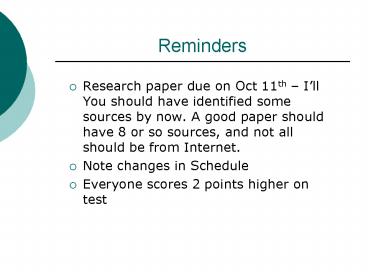Reminders - PowerPoint PPT Presentation
1 / 23
Title:
Reminders
Description:
A good paper should have 8 or so sources, and not all should be from Internet. ... Chiropractic Skull Manipulations. Biofeedback. Play Therapy. Herbs. Group Management ... – PowerPoint PPT presentation
Number of Views:31
Avg rating:3.0/5.0
Title: Reminders
1
Reminders
- Research paper due on Oct 11th Ill You should
have identified some sources by now. A good paper
should have 8 or so sources, and not all should
be from Internet. - Note changes in Schedule
- Everyone scores 2 points higher on test
2
Review
- Wiklers stress model
- Assessment Decision Making in Special Education
- Progress Monitoring
3
Assessment Terms
- Norm Referenced (age expectations)
- Criterion Referenced (standard of mastery)
- Authentic Assessment (progress monitoring)
- Portfolio Assessment
- Curriculum Based Measures
- Functional Behavioral Assessment (causes of
behavior)
4
ADHD Characteristics(Barkley, 1998)
Limited sustained attention or persistence of
attention to tasks
Reduced impulse control or limited delay of
gratification
Excessive task-irrelevant activity or activity
poorly-regulated to match situational demands
5
Common Difficulties Exhibited By Students with
ADHD
- Working Memory Difficulties
- Time Estimation Problems
- Difficulties Using Internal Language
- Lack of Self-Discipline
- Following Rules or Instructions
- Situational Variability in Performance
- Low Performance on Repetitive or Tedious Tasks
6
Introduction
- In the past decade, public awareness about ADHD
has increased. - The legal basis for services and protections
against discrimination for ADHD comes from the
IDEA and Section 504. - Unsuccessful efforts were made in 1990 to add
ADHD as a separate disability category under the
IDEA.
7
Introduction to ADHD
- Children with ADHD may also be served in other
special education categories such as - Learning disabilities
- Emotional or behavioral disorders
- Mental retardation
- A sizeable number of students with ADHD are not
qualifying for special education services under
the IDEA. - Many of these students receive accommodations
under Section 504.
8
Section 504 ADHD
Section 504 is not a special education law. It
is a civil rights law.
Section 504 has been and may continue to be the
primary legal basis for services to this
population.
Section 504 provides for a larger group
of students with disabilities and differs in
many respects from the IDEA.
9
Basic Concepts About ADHD
- ADHD is an invisible, hidden disability.
- ADHD is not hard to spot in the classroom.
- Many ADHD behaviors may be misinterpreted as
lazy, unorganized, and even disrespectful. - In the majority of cases, ADHD is a developmental
disability that becomes apparent before the age
of seven. - ADHD continues to be problematic for most
individuals during adulthood. - ADHD may have a negative impact on a students
academic and social success. - ADHD occurs across all cultural, racial, and
socioeconomic groups. - ADHD affects children and adults with all levels
of intelligence.
10
Doctors and Teachers and ADHD
- ADHD is typically diagnosed by a doctor
- Teachers and parents provide information
regarding how the child is doing - ADHD is distinguished from Conduct Disorder and
Oppositional Defiant Disorder
11
ADHS and ADD
- What difference does it make if you take out
the H
12
Role of Medication
- Many students with ADHD are prescribed
medications by physicians. - Teachers need to understand
- the types of medications used
- commonly-prescribed medication dosages
- the intended effects of medication and
- potential side effects of medication.
13
Desired Medication Outcomes
In 70 to 80 of the cases, children respond
positively to stimulants.
- Increased Concentration
- Completion of Assigned Tasks
- Increased Work Productivity
- Better Handwriting and Motor Skills
- Improved Social Relations with Peers Teachers
- Increased Appropriate Behaviors Emotional
Control - Reduction of Inappropriate Disruptive Behaviors
- Increased Self-Esteem
14
Psychostimulants
Psychostimulants are the most commonly-prescribed
medication for children with ADHD.
- Common Psychostimulants
- Dexedrine (dextroamphetamine)
- Ritalin (methylphenidate)
- Adderall (amphetamine salts)
15
Antidepressant Medications
- Prescribed less often than psychostimulants
- Generally used when stimulants are ineffective OR
when the individual is also depressed - Long-term use of antidepressants has not been
studied extensively - Types of antidepressants commonly used to treat
ADHD - Tofranil (imipramine)
- Nopramin (desipramine)
- Elavil (amytriptyline)
16
Antipyschotic Medications
- Much less frequently used than stimulants or
antidepressants - Types of Antipsychotic Medications Used to Treat
Children with ADHD - Mellaril (thioridazine)
- Thorazine (chlorpromazine)
- Catapres (clonidine)
- Eskalith (lithium)
- Tegratol (carbamazepine)
17
Teacher Considerations Regarding ADHD Medications
- Handle the dispensing of medication discreetly,
but according to school policy. - Make sure the medication is given as prescribed.
- Avoid placing too much blame or credit for the
childs behavior on the medication. - Monitor the behavior of the child, watching for
any medication side effects. - Communicate with the school nurse, parents,
and/or the physician.
18
Alternative Therapies for ADHD
- These therapies are offered as quick fixes and
have not been validated scientifically. - These therapies include
- Megavitamins
- Diet Restrictions (e.g., sugar or additives)
- Caffeine
- Massage Therapy
- Chiropractic Skull Manipulations
- Biofeedback
- Play Therapy
- Herbs
19
Group Management
- Classroom Rules
- Time Management
- Effective Grouping
20
Behavioral Supports
- Positive Reinforcement for Desired Behavior
- Premack Principle (Grandmas law)
- Contingency Contracting
- Cueing or Signaling
21
Modifying the Curriculum
- Students with ADHD need a curriculum adapted to
focusing on doing and one that avoids long
periods of sitting and listening. - Examples
- Experience-Based Learning
- Problem-Based Learning
- Varied Assessment Techniques
22
Test Adaptations
Extra Time
Frequent Breaks
Taking Exams in a Distraction-Reduced Environment
23
Self-Regulated Strategies
- Self-regulated strategies are interventions,
initially taught by the teacher, that the student
will eventually implement independently. - Self-regulated strategies address the core
problems of ADHD (e.g., impulsivity,
problem-solving, and self-regulation).































